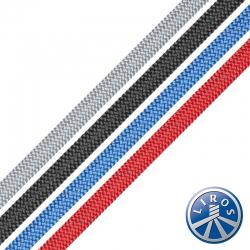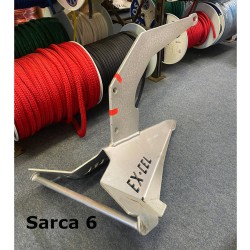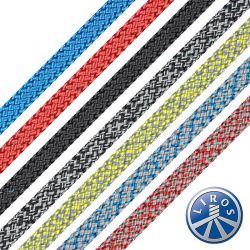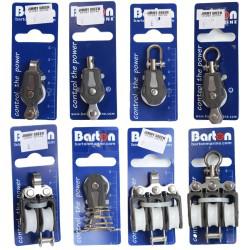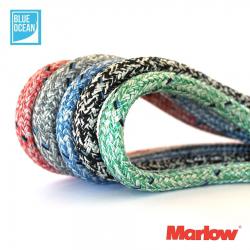
This guide explains the mechanics of mainsail control line systems, highlighting key components, purchase options and practical considerations to help you optimise sail trim and handling.
Yacht Mainsail Control Line Systems
The ability to manage sail power effectively is crucial for maintaining optimal boat handling. The high loads that sails must endure can pose significant challenges for both racing and cruising yachts, potentially leading to reduced manoeuvrability and excessive strain or damage to deck hardware, as well as compromised velocity made good (VMG). Reducing the effort required by the crew through precise sail-shape adjustment ensures safer and more efficient sail trimming. When selecting a control system, it is important to consider both the range of adjustment required and the level of mechanical advantage needed to achieve the desired sail shape.
Purchase Systems Explained
The common types of purchase systems used for sail control are block and tackle, cascade and a combination of the two. Control system components can also be referred to as having primary and secondary (crew handling) elements for more complex combinations.
1. Block and Tackle
This set-up typically consists of two blocks reeved together to make a purchase system. The blocks are usually shackled to strong points but can have one end attached to a pennant to extend the overall length of the system.
- 4:1 = a line passing through 4 sheaves
- 2:1, 4:1, 6:1 and 8:1 options are available. N.B. 6:1 and 8:1 require a lot more rope
- The sheaves can be side by side (double) or in line (fiddle) on a 4:1
- The purchase ratio equates to a corresponding increase in mechanical advantage
- Purchase System ratio options make them extremely versatile
- Visible movement of the block makes for easy calibration

2. Cascade System
This concept stacks multiple block-and-tackle units to achieve very high purchase in a limited space.
- The cascade is created by adding a further 2:1 block to the free end of an initial 2:1 set-up. Adding a third block will double the advantage of the cascade to 8:1
- Can be packaged under the boom in a compact way
- Highly powerful over a shorter range of movement
- Allows for progressively downsized turning blocks as more cascades are added
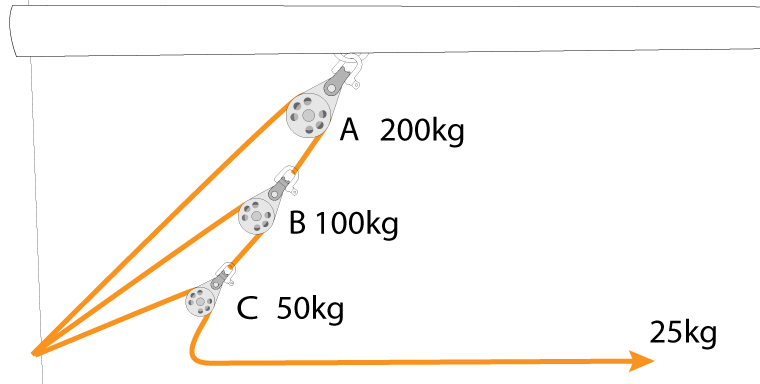
What are Control Lines?
All lines that affect sail trim and shape can be considered 'control lines'. This includes sheets, guys, pole uphauls, in-haulers and reefing lines. Below, we review the three primary mainsail-shape control lines. These are the kicker, downhaul and outhaul.
Purchase Set-ups by Control Line
Kicker / Boom Vang
Loads on the kicker can be extremely high owing to the force vector on the boom not being in line with the desired downward movement of the boom. A good range of adjustment is required to maintain appropriate leech tension on all points of sailing.
- 4:1: Two double blocks and tackle – ideal for cruising keelboats up to 30 ft
- 8:1: Combines a primary 2:1 cascade with a secondary 4:1 block and tackle. This is better suited for yachts over 30ft and is commonly used with rod kickers
- 16:1 Cascade: 2 x 2:1 cascades leading into a 4:1 block-and-tackle system—compact yet super powerful, favoured in performance set-ups
Outhaul
Perhaps the least adjusted of all the sail controls because it controls the least power in the lower third of the sail. Low-ratio set-ups are common on all but the most powerful mainsails.
- 2:1: There are two easy cruise set-up options:
- Simple cheek block on the boom and a becket block with a pennant to the clew
- Use the end of the boom as a becket and the clew eye to create the 2:1 turning point. A block can be added to the clew to reduce friction
- 4:1: Combine the two options above for improved fine control in heavier winds
Downhaul / Cunningham
The downhaul is responsible for controlling power in the upper half of the sail. High loads are required to pull the tack of the sail down for effective de-powering. This becomes progressively harder to achieve as the mainsail size increases and as the wind picks up. Skippers of yachts over 20ft may then prefer to reef the sail for optimum power control.
- A 2:1 set-up is typically created by attaching a line to a mast tang below the gooseneck and passing it up and through the tack cringle
- From here, further block-and-tackle purchases can be added as required
- For low-powered sails, a further 2:1 should suffice
- For higher-powered sails, strong luff tension is created with a further 4:1 block and tackle (8:1) or a triple block and tackle (12:1)
Key Considerations When Choosing a System
- Yacht Length and Sail Area – Larger sails demand a higher mechanical advantage.
- Crew Strength – Systems should match your crew’s trimming capability.
- Space Constraints – Cascades save deck space without sacrificing power.
- Control Precision – More purchase = finer adjustment and more stable trim.
- Maintenance and Durability – Top-quality blocks and lines are essential for safe, long-term performance.
Main Menu
Main Menu
Back
Main Menu
Back
Main Menu
Back
Back
Main Menu
Back
Main Menu
Back
Back
Main Menu
Back
Main Menu
Main Menu
Back
Main Menu
Back
Back
Back
Back
Back
Back
Back
Back







